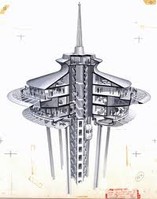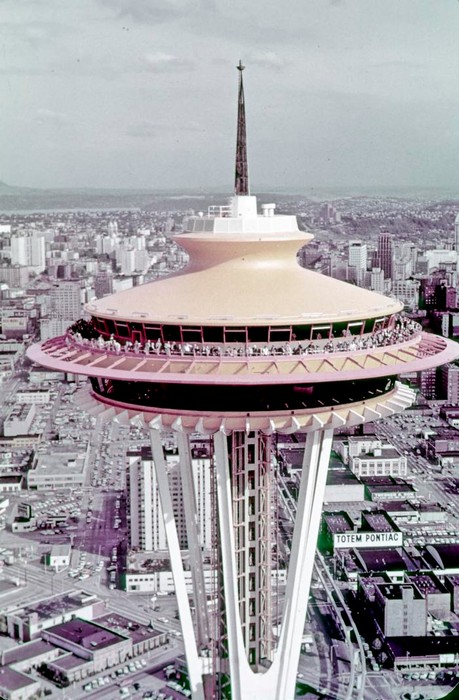Space Needle
Introduction
Text-to-speech Audio
Rising 605 feet high, the Space Needle was built for the 1962 World's Fair and has been one of the leading landmarks of the Pacific Northwest and a symbol for the city of Seattle. The fair drew over 2.3 million visitors, and nearly 20,000 people used its elevators each day during the 1962 World's Fair to reach what was then the tallest structure west of the Mississippi River. The fair was made possible by a 1957 bond that supported a new civic center and fairground development, while the federal government dedicated $9 million to build the U.S. Science Exhibit, which now serves as the Pacific Science Center. Marketing for the fair included space-age images of the needle and exhibits, along with a jingle that implored listeners to "Skidaddle to Seattle" for the fair. The tower was built to withstand winds of up to 200 miles per hour and earthquakes of up to 9.1 magnitude and has 25 lightning rods. On May 19, 2007, the Space Needle welcomed its 45 millionth visitor. The guest received a free trip for two to Paris, along with a VIP dinner at the Eiffel Tower. Every year on New Year's Eve, the Space Needle celebrates with a fireworks show at midnight that is synchronized to music. In April of 2012, as part of the 50th anniversary celebration, the Space Needle was painted Galaxy Gold, the same color used when it was constructed for the 1962 World's Fair.
Images


The Space Needle shortly after its completion

Backstory and Context
Text-to-speech Audio
In 1959, artist Edward E. Carlson sketched a vision of the Space Needle on a napkin in a coffee house. He was inspired by the Stuttgart Tower in Germany. His goal of his "space-age" image was to be the focus of the futuristic World's Fair in Seattle, which had the theme of exploring the 21st century. Carlson's initial sketch of the Space needle underwent many changes, experimenting with features from a tethered balloon to a balloon-shaped top house. John Graham, the architect of the world's first shopping mall, turned the balloon design into a flying saucer. Graham finished the design just a year and a half before the World's Fair.
The next challenge was location and financing. The Space Needle needed to be privately financed on land that was available for public purposes. It wasn't until 1961, only a year before it was finished, that this location was sold to investors at $75,000. Construction was managed by the Howard S. Wright Construction Company who first built a foundation that would weigh as much as the Space Needle itself. As a result, the tower's center of gravity is just five feet above ground. The 605-foot tall Building was completed in December 1961, and was opened four months later on the first day of the World's Fair, April 21, 1962.
The five-level top house dome was finished with special attention to the revolving restaurant, which was rotated with just one horsepower electric motor, and the observation deck. The final painting consisted of astronaut white for the legs, orbital olive for the core, re-entry red for the halo, an galaxy gold for the sunburst and roof. From the top of the Space Needle, you can observe downtown Seattle, the Olympic and Cascade Mountains, Mount Rainier and Mount Baker, Elliot Bay, and the surrounding islands.
Sources
King 5 Seattle. Doodle to a needle: A timeline of the Space Needle's 60-year history in Seattle, April 20th, 2022. Accessed April 9th, 2024. https://www.king5.com/article/news/local/timeline-space-needle-history/281-1f509e2b-a4b1-4f23-bb79-66c75b0a3896.
Walser, Lauren. The Space Needle, By the Numbers. Preservation Magazine, National Trust for Historic Preservation .
History of the Space Needle, Wikipedia, http://en.wikipedia.org/wiki/Space_Needle http://www.spaceneedle.com/history/
https://www.seattle.gov/cityarchives/exhibits-and-education/online-exhibits/the-city-and-the-worlds-fair
